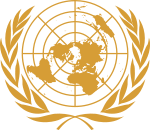Chapter VI of the United Nations Charter
- Chapter VI of the United Nations Charter
-
Chapter VI of the United Nations Charter deals with peaceful settlement of disputes. It requires countries with disputes that could lead to war to first of all try to seek solutions through peaceful methods such as negotiation, enquiry, mediation, conciliation, arbitration, judicial settlement, resort to regional agencies or arrangements, or other peaceful means of their own choice." If these methods of alternative dispute resolution fail, then they must refer it to the UN Security Council. Under Article 35, any country is allowed to bring a dispute to the attention of the UN Security Council or the General Assembly. This chapter authorizes the Security Council to issue recommendations but does not give it power to make binding resolutions; those provisions are contained Chapter VII.[1][2][3] Chapter VI is analogous to Articles 13-15 of the Covenant of the League of Nations which provide for arbitration and for submission of matters to the Council that are not submitted to arbitration. United Nations Security Council Resolution 47 and United Nations Security Council Resolution 242 are two examples of Chapter VI resolutions which remain unimplemented.
References
- ^ Collective Insecurity, Harvard International Review,"Chapter VI establishes the appropriate methods of settling international disputes and the Security Council's powers in relation to them. It is generally agreed that resolutions under Chapter VI are advisory rather than binding. These resolutions have generally been operative only with the consent of all parties involved. Traditionally, the Chapter has not been interpreted to support collective intervention by member states in the affairs of another member state"
- ^ Possible Extension of the UN Mandate for Iraq: Options, 'The basic difference between Chapters VI and VII is that under Chapter VII, the Council may impose measures on states that have obligatory legal force and therefore need not depend on the consent of the states involved. To do this, the Council must determine that the situation constitutes a threat or breach of the peace. In contrast, measures under Chapter VI do not have the same force, and military missions under Chapter VI would rest on consent by the state in question'
- ^ History of failed peace talks, BBC, 2007-11-26
Categories:
- United Nations peacekeeping
- Divisions and sections of the United Nations Charter
- United Nations stubs
Wikimedia Foundation.
2010.
Look at other dictionaries:
Chapter VII of the United Nations Charter — sets out the UN Security Council s powers to maintain peace. It allows the Council to determine the existence of any threat to the peace, breach of the peace, or act of aggression and to take military and nonmilitary action to restore… … Wikipedia
Chapter I of the United Nations Charter — lays out the purposes and principles of the United Nations organization. These principles include the equality and self determination of nations and the obligation of member countries to obey the Charter, to cooperate with the UN Security Council … Wikipedia
Chapter IV of the United Nations Charter — contains the Charter s provisions dealing with the UN General Assembly, specifically its composition, functions, powers, voting, and procedures. Contents 1 Primacy of the General Assembly 2 Articles 10, 11, 12, 13, 14, 15, and 16 3 Article 17 … Wikipedia
Chapter II of the United Nations Charter — deals with membership of the United Nations organization. Membership is open to the original signatories and all other peace loving states which accept the obligations contained in the present Charter and, in the judgment of the Organization, are … Wikipedia
Chapter III of the United Nations Charter — summarizes the principal organs of the United Nations. They are listed in the same order as the chapters detailing their composition, functions, and powers appear in the Charter. The placement of the General Assembly first in the list probably is … Wikipedia
Chapter IX of the United Nations Charter — deals with international economic and social cooperation. Article 55 reflects the philosophy of the UN that efforts should be made to impact the root causes of war: With a view to the creation of conditions of stability and well being which are… … Wikipedia
Chapter XVI of the United Nations Charter — contains miscellaneous provisions prohibiting secret treaties, establishing the UN Charter as supreme over any other treaties, and providing for privileges and immunities of UN officials and representatives. Contents 1 Article 102 2 Article 103 3 … Wikipedia
Chapter V of the United Nations Charter — contains provisions establishing the United Nations Security Council. Article 23 establishes the composition of the Security Council, with five permanent members (the Republic of China, France, the Soviet Union, the United Kingdom, and the United … Wikipedia
Chapter VIII of the United Nations Charter — deals with regional arrangements. It authorizes regional organizations (such as NATO) and even requires attempts to resolve disputes through such agencies (if available) prior to intervention by the UN Security Council. However, Article 53… … Wikipedia
Chapter XV of the United Nations Charter — deals with the UN Secretariat. It designates the UN Secretary General as the chief administrative officer of the organization, which includes the staff of ECOSOC, the Trusteeship Council, and other organs. Similarly to how the US Constitution… … Wikipedia

